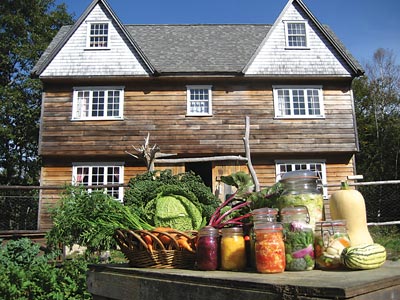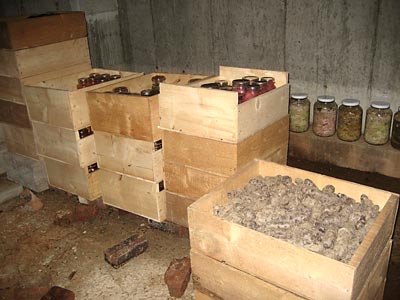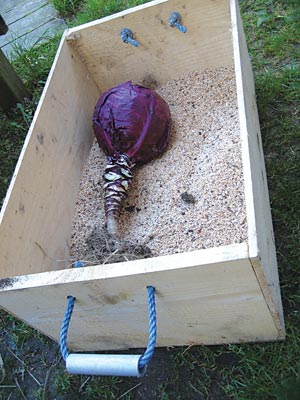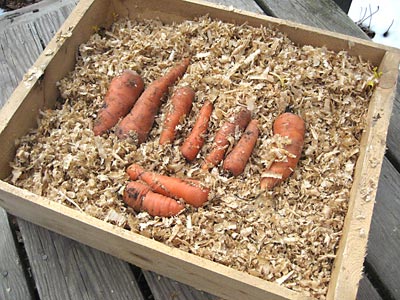 |
| Vegetables ready for storage – some fermented, some as harvested. |
 |
| We store carrots, beets, rutabagas and celeriac in wooden boxes with damp spruce wood shavings. The uniform boxes stack and keep out rodents. The boxes also were sized to hold Mason jars. |
How we store our year-round supply of produce
By Anneli Carter-Sundqvist
Photos by the author
No produce tastes better than that picked fresh in the garden and brought straight to the plate; but a close second is the meal grown and picked in the same garden, and then stored and brought to the plate in the depth of winter.
Keeping food through winter is rewarding and can be simple. For the first few years of homesteading on Deer Isle, my husband, Dennis, and I expanded our food production and improved our storage methods so that now we eat almost exclusively from our gardens all year. We use low-energy techniques that require little time and equipment, such as a naturally cool root cellar, drying, fermenting and canning. Some crops keep fresh until June; we run out of others before they go bad.
Storing food for winter starts in spring with garden planning. Different varieties of the same crop keep differently. Sweeter onion varieties, for example, have a limited storage life, while denser, more pungent varieties keep well; so I grow ‘Ailsa Craig’ as a summer onion and ‘Copra’ to store. When planning our gardens, I prioritize storage varieties. For example, we plant fewer summer squash, which ripen at the same time as so many other vegetables, and more winter squash, which we enjoy into late spring.
Fresh Storage
Storing garden produce fresh requires finding a place with the right temperature and humidity for different crops. We work with three general areas: cool/damp, cool/dry and warm/dry.
The root cellar is our primary, cool/damp storage area. Most root crops do best at temperatures from 32 to 40 F with 85 to 95 percent relative humidity. We reach our 11- by 19-foot cellar under our house via a trap door and a ladder from the kitchen. We open or close the two windows on opposite ends of the cellar to control the temperature, monitoring the temperature with a digital thermometer in our kitchen and a wireless sender in the cellar.
We pack carrots, beets, rutabagas and celeriac in wooden boxes with damp spruce wood shavings to help keep the produce moist and cool, especially in spring, when our cellar quickly gets too warm. We initially used sawdust, which worked great but was too messy in the kitchen. We built the boxes uniformly so that they stack and keep out rodents. The boxes also were sized to hold mason jars.
We store cabbage the same way but in much bigger boxes. I pull cabbage plants with the root and remove several layers of outer leaves to eliminate any worms and slugs, and I spray the roots with a garden hose for the same reason.
We pick Chinese cabbages the same way, but we “replant” them in sawdust just as they sat in the ground. Another box may be flipped over the heads to keep out light and rodents.
 |
| Cabbage is stored in bigger boxes. |
We also store several bushels of fresh apples and pears in our cellar. A good fresh storage fruit has no bruises (it is picked from the tree and handled carefully), has a stem and has no signs of insects. We advise learning which varieties store well and how to identify them. (Come to MOFGA’s Common Ground Country Fair on September 23-25, or to The Great Maine Apple Day at MOFGA on October 16, 2016, for help.) When we encounter unknown apple varieties, we put a small amount in our cellar the first winter to note their storing capacities.
Onions, garlic and leeks all spend the winter in our mudroom, which stays colder and much drier than the cellar. Even with occasional freezing, they’re fine.
Winter squash must be kept dry and takes some warmth. We place ours in our former sleeping loft. Usually we eat our ‘Waltham Butternut’ squash until June, when they are as firm and sweet as in December.
Fermenting
I grow hundreds of heads of cabbage and turn about 30 gallons into sauerkraut each year. Fermentation enables me to use damaged vegetables, such as cracked heads of cabbage or cracked carrots. It also allows me to preserve some summer-garden surplus – beans, cauliflower, broccoli, garlic scapes and salsa – without using a freezer.
To make sauerkraut, I shred cabbage, add 5 or 6 tablespoons of salt per 8 pounds of produce, and pack the mixture tightly in jars. Salt pulls water from the crushed produce – that’s the brine. For vegetables that I don’t want to crush, such as cauliflower and corn, I put the produce in a clean quart jar, add seasoning such as garlic, onions and spices, fill the jar with water and add 1 1/2 tablespoons of salt. Fermenting requires no cooking or heating, and I can make several jars in minutes. When I’m about to use the vegetables, I pour out the brine and fill the jar with clean water to eliminate most of the salt. We eat the vegetables as is or in soups and stews.
I get gallon jars for sauerkraut from a restaurant down the road that otherwise would throw them in the dumpster, and I reuse them every year, as long as the metal lid holds up against rust and wear. For other produce I use quart Mason jars, preferably those with glass lids and rubber gaskets. When we run out of these, we use standard jars with metal lids.
Drying
Drying fruit, vegetables and herbs is a shelf-stable way to preserve food and is easy to do without special equipment. A good drying space should be above 80 F and dry, with air moving around so that products don’t spoil. I use the third-floor attic through the summer, closing the windows before rains to minimize moisture. Produce needs to be protected from bugs and from direct sunlight by, for example, spreading a thin bed sheet over it. I put the dried products in paper bags or in Mason jars with cloth as the lid. I store herbs and flowers in glass jars away from light.
 |
| Carrots in damp spruce shavings. |
I dry a lot of flowers – rose petals, chamomile, yarrow, red clover and calendula – for tea and medicine, as well as culinary herbs and greens – parsley, sage, kale and celery tops. I also dry chanterelle and shiitake mushrooms by slicing them thinly and spreading them on screens.
We also store flint and sweet corn on husked cobs in the attic. We enjoy corn all winter by soaking the kernels for 12 hours and cooking them in our pressure cooker.
In the fall I pick ‘Wolf River’ apples, slice them and dry them on racks over the wood stove. Cut thin enough, they dry in two days, and in a matter of a few weeks I stock up on gallons and gallons of dried apple slices for trail mix or to rehydrate in my breakfast cereal.
Canning
Canning requires more time and fuel than our other storage methods, so we use it only for things we can’t preserve any other way. We can many, many jars of tomatoes (which we also ferment, but they tend to get quite acidic when fermented and are good only in small amounts) and bushels of fruit and berries. I seal the lids in a boiling water bath. To make the canning as fuel-efficient as possible, I make sure I have enough produce to make 35 to 40 pints or 20 to 25 quarts so that once I get the process going, I maximize use of the heated water. Apples and pears I cook just enough so that I can mash them, and berries I heat quickly, drain, and save any excess liquid. These, too, I process in a boiling water bath.
A Key to Self-Sufficiency
Even if you don’t grow all your own produce, as we do, you can buy in bulk to make fewer trips to market. In the fall, many farmers have “second grade” bulk produce that can’t be sold at full price but might well be worth its keep.
For us, the gardens are only one part of the puzzle; setting up boxes and jars and getting the experience of storing food on our scale has been a natural progression. Our food production is central to our homesteading and to our lifestyle, and I can’t emphasize enough the importance of low-energy food storage. For me, a key to self-sufficiency is the ability to keep food without a freezer, refrigerator, fuel-consuming processing or artificially cold (Coolbot-controlled) rooms. I see no point in investing so much time in the gardens if we don’t know how to keep what we produce. I have no interest in selling vegetables in August only to buy the same products from Canada or California in March. Like many people in rural areas, our access to local and organic produce is limited, unless we’re willing to drive far to buy it. Now, with only a short climb down to the cellar or a quick reach up to the tea shelf, we can enjoy the summer bounty all year.
About the author: Anneli Carter-Sundqvist grew up in the north of Sweden and came to Maine in 2008. She is the author of “A Homesteader’s Year on Deer Isle” (self-published, 2014). See www.deerislehostel.com for more information.
